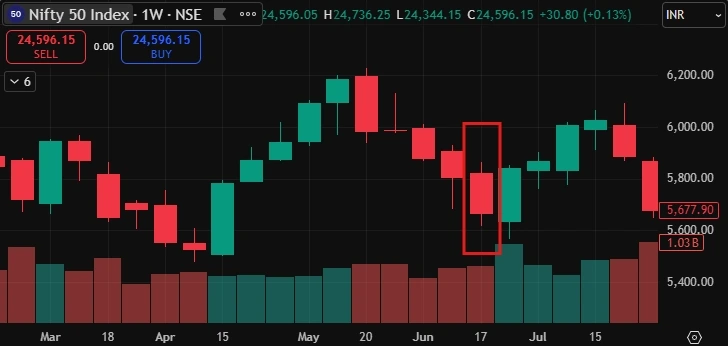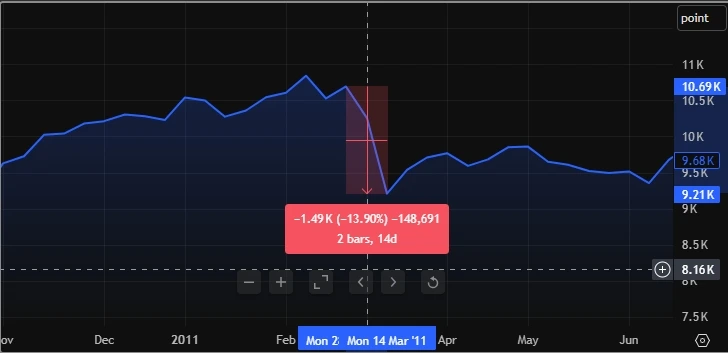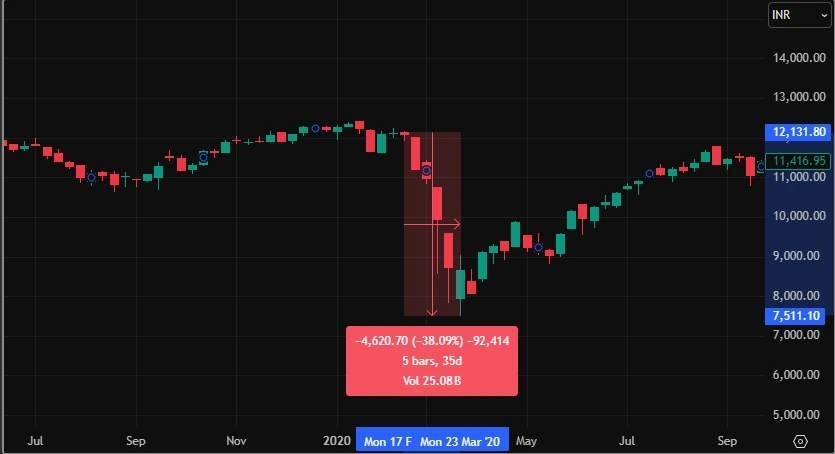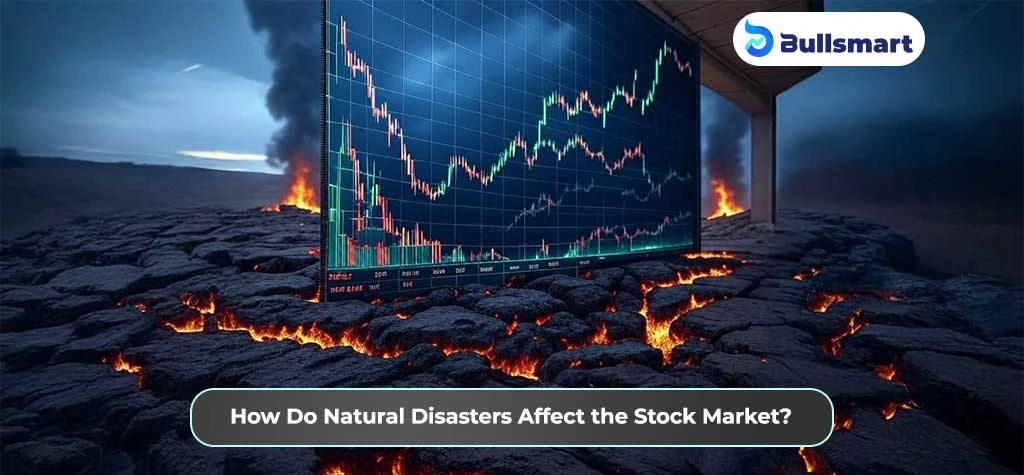When a flood submerges a city, an earthquake levels infrastructure, or a virus halts the world, the shock isn’t just physical. It reverberates through economies rattles global stock markets.
In 2020 alone, natural disasters and extreme weather events led to global losses of over ₹17.5 lakh crore. Back home, during the peak of the COVID-19 panic, ₹14 lakh crore in market capital was wiped out in just one trading session showing how quickly investor sentiment can unravel.
From the Hiroshima atomic blast to the Uttarakhand floods and the global tremor caused by COVID-19, history has shown that natural disasters affect the stock market in ways both immediate and far-reaching. Investors panic, companies halt operations, supply chains break, and sectors like insurance, agriculture, and tourism take a direct hit.
The stock market reaction to disasters can be swift and brutal; indices plunge, volatility spikes, and recovery timelines stretch unpredictably. Yet, some sectors rebound stronger, while others take years to recover, if at all.
This blog explores the impact of natural disasters on stock markets, backed by real-life case studies, market data, and India’s unique position in the global financial ecosystem. As India races ahead with record-breaking GDP growth, the country continues to grapple with floods, droughts, and internal insurgencies creating a paradox few global investors can afford to ignore.
Suggested Read: Top Hedge Funds in India to Invest for a Secured Portfolio in 2025
Why Natural Disasters Shake the Markets
Stock markets thrive on predictability and natural disasters are the ultimate disruptors. Whether it’s an earthquake in Japan, a flood in India, or a global pandemic, disasters inject uncertainty, damage infrastructure, and shake investor confidence, all of which directly impact financial markets.
Here’s why the stock market reacts to natural calamities so sharply:
Investor Panic and Risk Aversion
Disasters trigger fear. Retail investors often rush to sell, and institutional investors shift to safer assets like gold or government bonds. This creates a “risk-off” sentiment, leading to sharp market sell-offs.
Sectoral Damage
Industries like insurance, infrastructure, tourism, and agriculture suffer the most.
For instance, during the 2013 Kedarnath (Uttarakhand) floods, a study found negative abnormal returns in BSE-listed infrastructure and utility firms from affected regions highlighting immediate investor consequences.
The 2015 Chennai floods resulted in insurance claims totaling around ₹4,800 crore, with about 50,000 claims filed, a significant hit to insurers and related sectors.
Supply Chain Disruption
Natural disasters break transportation, delay production, and interrupt exports, especially in globally connected economies like India. Stocks of companies dependent on complex supply chains often take a hit.
GDP and Earnings Impact
Natural disasters can cause major disruptions in economic output and corporate earnings.
For example, the 2013 drought in Maharashtra reduced crop production by up to 21%, leading to an estimated 0.5% dip in India’s GDP,a loss of around $9 billion. Similarly, the 2022 floods in Spain were projected to cut 0.2% from quarterly GDP, showing how even short-term events can affect national economies.
Lower GDP and profit warnings from affected companies often trigger market-wide corrections and volatility, especially in agriculture, infrastructure, and energy sectors.
Short-Term Volatility, Long-Term Repricing
While markets often recover after a few months or quarters, disasters sometimes reshape long-term investor strategy shifting interest toward resilient sectors like healthcare, renewable energy, or ESG-aligned companies.
Suggested Read: Geopolitical Events: The Profound Shockwaves Shaping Financial Markets in 2025 & Top Healthcare Sector Stocks in 2025 for a Healthy Portfolio
How Do Natural Disasters Affect the Stock Market?
Natural disasters profoundly disrupt economies and investor confidence, often leading to significant stock market volatility and instability. Understanding the main channels through which these events impact markets is crucial for investors, policymakers, and businesses aiming to build resilience.
Key Drivers of Market Impact
Supply Chain Disruption Natural Disaster
When factories, ports, and transportation networks are damaged or destroyed, the flow of goods and raw materials slows or stops. This disruption causes shortages, increased costs, and sector-specific price volatility. For example, the 2011 Japan Earthquake and Tsunami disrupted global automotive and technology supply chains, leading to a sharp 10% fall in the Nikkei 225 index.
Infrastructure Damage Stock Market Effects
Damage to critical infrastructure; roads, energy grids, communication systems directly hampers business productivity and operations. These losses translate into decreased corporate earnings, negatively affecting stock prices and overall market indices.
Economic Uncertainty After Disaster
Disasters create uncertainty about the scale of damage and recovery timelines. Such ambiguity often triggers investor sentiment disasters, leading to panic selling and steep market declines. The COVID-19 stock market effect exemplifies this, with global indices experiencing historic crashes followed by prolonged volatility.
India’s Distinct Disaster and Market Challenges
India’s fast-growing economy faces frequent natural disasters such as floods, cyclones, and droughts, which contribute to ongoing India GDP growth challenges. The Kedarnath Floods, 2013, for instance, disrupted regional supply chains and devastated local economic activity but had limited impact on national stock indices (Sensex, Nifty). This resilience is due to India’s robust economic fundamentals and growing investor confidence despite recurring natural disaster news.
Why Understanding This Matters
Grasping how natural and biological disasters translate into market risks equips stakeholders to navigate disaster economic impact effectively. Integrating risk management practices and preparedness into economic and investment planning can mitigate shocks and foster more sustainable market recovery after calamities.
6 Real-Life Case Studies: When Disasters Moved the Markets
Case Study 1: Hiroshima Blast, 1945 (The Original Shockwave)
Background
- Catastrophic man-made disaster with massive infrastructure destruction.
- Limited stock market data from that era, but enormous economic and social upheaval.
Economic Impact
- Extensive supply chain disruption and production halts.
- Investor confidence plummeted amid uncertainty over recovery timelines.
- Deep and prolonged economic uncertainty after disaster.
Market Takeaways
- Demonstrates how man-made disasters cause lasting negative market sentiment.
- Highlights the role of infrastructure damaging the stock market and depressed investor sentiment disasters.
- Foundations for understanding disaster market responses beyond natural causes.
Case Study 2: Kedarnath Floods, 2013 (India’s Economic Toll)
Background
- The Kedarnath Floods of June 2013 were triggered by unprecedented heavy monsoon rainfall combined with glacial lake outbursts in the Himalayan region, particularly devastating the Kedarnath valley in Uttarakhand.
- This tragic event led to massive flash floods and landslides that caused widespread destruction of towns, roads, bridges, and religious pilgrimage sites.
- Over 6,000 lives were lost, and thousands were displaced, marking it one of India’s most devastating recent natural disasters.
Ecological and Infrastructural Impact
- Severe soil erosion, loss of vegetation, and destabilization of riverbanks occurred, negatively affecting agriculture and biodiversity.
- Approximately 3,000 kilometers of roads and many bridges were damaged or destroyed, complicating relief and rehabilitation efforts.
- The destruction of infrastructure disrupted transportation, communication, and supply chains, causing inflation and scarcity of essentials.
Economic Impact
- Tourism, the region’s economic mainstay, especially pilgrimage tourism around Kedarnath temple, suffered catastrophic losses. Over 5,000 hotels, lodges, and guesthouses were damaged or destroyed, sharply reducing tourist arrivals and associated employment.
- Agricultural lands were either washed away or rendered infertile, and irrigation infrastructure was damaged, severely affecting local farmers. Livestock losses further distressed rural livelihoods.
- The state government faced significant financial burdens for rescue, relief, and rebuilding efforts, with estimated reconstruction costs exceeding ₹4,000 crores. Insurance coverage gaps meant many businesses and families bore enormous losses without sufficient compensation.
- Extensive government aid, including INR 73.5 billion from central and international sources, was mobilized for medium- and long-term recovery.
Market and Social Takeaways
- The floods caused significant supply chain disruption, natural disaster and economic uncertainty after disaster in the region, with local businesses and markets struggling to recover.
- Despite localized devastation, broader Indian stock markets showed resilience, supported by the country’s sustained economic growth fundamentals and investor confidence.
- The event highlighted the fragility of infrastructure in disaster-prone zones and the critical need for sustainable, climate-adaptive planning and disaster preparedness.
- Significant migration from affected areas triggered by economic instability further weakened local economies, emphasizing the long-term repercussions of such disasters.
- Coordinated reconstruction efforts including improved infrastructure, environmental restoration, and tourism rehabilitation have been vital in fostering gradual economic recovery.
You can see in this chart how the market dipped during the crisis:

Source: TradingView
Case Study 3: 2011 Japan Earthquake & Tsunami (Economic Impact and Market Response)
Background
- One of the costliest disasters, with damaged infrastructure and nuclear crisis fallout.
- Over 23,000 dead or missing; rolling blackouts in industrial zones.
Economic Impact
- Japan entered recession; Nikkei 225 fell sharply due to halted supply chains.
- Government stimulus and rebuilding gradually restored investor confidence.
Market Takeaways
- Highlights acute economic uncertainty after disaster and sharp market volatility.
- Showcases critical role of government intervention post-disaster.
- Severe infrastructure damages the stock market and supply chain disruption effects.
You can see in this chart how the market dipped when tsunami hit Japan:

Source: TradingView
Case Study 4: COVID-19 Pandemic, 2020 (Global Market Collapse and Economic Shock)
Background
- Unprecedented biological disaster with global lockdowns and supply chain breakdowns.
- Stock indices worldwide saw the steepest declines since 1987.
Economic Impact
- Global commerce dropped 7%, with sectors like travel and hospitality the hardest hit.
- Triggered acute stock market crash disaster and ongoing pandemic stock market volatility.
- Massive fiscal stimuli deployed amid inflation and shortages.
Suggested Read: Market Crashes: A Devastating Truth You Can’t Ignore
Market Takeaways
- Underlined vast biological threats market impact on investor sentiment and markets.
- India’s India GDP growth challenges accentuated but digital growth accelerated.
- Demonstrates critical need for pandemic preparedness in economic planning.
You can see in this chart how the market dipped when Covid hit India:

Source: TradingView
Case Study 5: Kerala Floods, 2018 (Regional Market Effects in India)
Background
- Severe monsoon rainfall caused widespread flooding damaging infrastructure and agriculture.
- One of the worst recent natural disasters in India.
Economic Impact
- Regional banks and companies experienced stock price volatility.
- Key industries like rubber/tyre production reported short-term setbacks.
- NSE Sensex and Nifty 50 showed broader resilience.
Market Takeaways
- Localized disasters trigger economic uncertainty after disaster and supply chain disruption natural disaster.
- Broader markets stayed stable supported by India’s robust fundamentals.
- Reflects India’s growth balancing recurring natural disaster risks.
Case Study 6: Hurricanes Katrina (2005) & Sandy (2012) (U.S. Market Volatility and Economic Impact)
Background
- Katrina flooded 80% of New Orleans causing over $200 billion in losses; Sandy hit the US East Coast with significant damage.
- Massive job losses, especially in retail, healthcare, and port operations; tourism shutdowns prolonged economic effects.
Economic Impact
- Energy prices spiked due to refinery shutdowns; commodities market volatile.
- Long recovery involving federal aid and rebuilding efforts took years.
- Stock markets showed volatility tied to infrastructure damage and economic disruption.
Market Takeaways
- Demonstrates how disasters affect commodity and regional markets through infrastructure and job losses.
- Highlights recovery as a multi-year process influencing investor confidence.
- Reinforces long-term economic repercussions shaping market dynamics.
Suggested Read: Why Does the Stock Market Fall? 5 Devastating Truths You Can’t Ignore
India’s Economic Growth vs Natural Disaster Risks
India is currently one of the fastest-growing major economies in the world. In 2025, its GDP growth is expected to outpace several developed nations, a signal to global investors that India is the next big bet.
But beneath this headline growth lies a complex truth: India remains dangerously exposed to natural disasters, including floods, droughts, heatwaves, landslides, and cyclones, many of which cause large-scale displacement, infrastructure damage, and economic loss.
The Vulnerability Behind the Growth Story
- According to the Asian Development Bank, climate change may shave off up to 25% of India’s GDP by 2070 if risks are not mitigated.
- Nearly 68% of India’s cultivable land is drought-prone, and 12% is flood-prone, making agriculture and rural economies extremely sensitive to climate volatility.
- States like Assam, Uttarakhand, Kerala, and Odisha have faced repeated extreme weather events, each impacting regional stock performance, particularly in insurance, infrastructure, and FMCG stocks.
Internal Disruptions Add to the Risk
India also faces internal insurgencies, infrastructure challenges, and regional conflicts. These often go under-reported but can affect:
- PSU stocks, especially those tied to infrastructure, energy, and defense.
- Sentiment among Foreign Institutional Investors (FIIs) who are risk-sensitive to socio-political instability.
For instance:
- The Manipur ethnic conflict and North-East insurgencies have affected telecom and power infrastructure rollouts in the region.
- Natural disasters in tandem with internal unrest double the investment risk and this is something even retail investors are waking up to.
Monsoons Still Move Markets
Despite India’s march toward digitization and financial modernization, the stock market still reacts to monsoon forecasts. Poor rainfall impacts:
- Agri stocks (like UPL, Dhanuka)
- FMCG stocks (like HUL, Dabur)
- Rural banking and NBFCs
In many ways, India’s stock market remains weather-dependent, a reminder that high GDP numbers alone don’t guarantee resilience.
Suggested Read: Top Monsoon Stocks to Watch in 2025: Sectors That Profit with the Rains
Which Sectors Remain Stable During Natural Disasters
Every natural disaster, whether it’s a flood, earthquake, or pandemic, hits sectors differently. Some collapse under operational strain, while others adapt or even thrive.
Here’s a sector-wise breakdown of typical market behavior during and after major disaster events:
| Sector | Disaster Impact | Example Stocks (India) |
| Insurance | Short-term hit due to claims; long-term gain from increased awareness & premiums | LIC, ICICI Lombard |
| Infrastructure | Severe immediate losses; recovery likely during reconstruction phase | L&T, IRB Infra |
| Agriculture | Highly vulnerable to droughts, floods, and erratic monsoons | UPL, Dhanuka Agritech |
| FMCG & Retail | Supply chain disruptions; rural demand dips during crop failure | HUL, Dabur, Marico |
| Banking & NBFCs | Rural loan defaults rise; disaster insurance exposure risks | SBI, Bandhan Bank, M&M Finance |
| Tourism & Airlines | Among the hardest hits during pandemics, floods, and geopolitical disruptions | Indigo, IRCTC, Indian Hotels |
| Pharma & Healthcare | Strong performers during pandemics or bio-risk events | Sun Pharma, Cipla, Apollo |
| Tech & Telecom | Generally resilient unless infra damage is massive | Infosys, TCS, Bharti Airtel |
| ESG & Renewables | Gain investor interest post-disaster due to sustainable investing shift | Adani Green, Tata Power |
Key Insights for Investors
- Disaster impact on Indian stock market is not uniform, it’s about knowing where the shockwaves land first.
- Stocks linked to basic needs, healthcare, and digital infrastructure tend to show resilience or even growth.
- Insurance and infrastructure stocks may fall initially but often benefit from government stimulus or rebuilding demand.
Smart investors track not just the event, but the market response timeline, the lag between disaster impact and price recovery can signal entry points.
Suggested Read: Top FMCG Stocks to Invest in 2025 for Explosive Returns
Beyond Nature: The Threat of Bio-Wars & Virus Outbreaks
While earthquakes and floods are sudden and visible, the most devastating market shocks in recent history came not from nature but from biology.
The COVID-19 pandemic didn’t just challenge healthcare systems, it caused one of the fastest and most widespread global stock market crashes in modern history.
The Market Collapse of 2020
- In March 2020, Indian equity markets lost ₹52 lakh crore in market cap in just one month.
- NIFTY and SENSEX saw their steepest single-day falls since the 2008 financial crisis.
- Sectors like aviation, tourism, retail, and banking were decimated.
- Pharma, FMCG, and tech stocks, on the other hand, surged.
It wasn’t just a public health crisis, it was an economic and financial earthquake.
The Rise of Bio-Risk as a Market Factor
What COVID proved is this: disasters are evolving. In a globally connected world, the next major market meltdown may not be from a tsunami or cyclone, but from a lab leak, bio-terrorism, or digital virus pandemic.
- Bio-warfare and synthetic viruses are now listed among top risks by WEF and NATO economic analysts.
- Stock markets will increasingly factor in “bio-resilience” when pricing companies and geographies.
- Investors may start treating sectors like biotech, cybersecurity, and ESG-compliant companies as hedges against invisible global threats.
Are We Ready?
India, with its massive population density and relatively underdeveloped healthcare infra in rural areas, remains highly vulnerable to pandemics and bio-risks. Any future outbreak could:
- Trigger another round of panic selling and volatility
- Affect foreign investor sentiment
- Expose gaps in pharma supply chains and health-tech access
Suggested Read: India-Pakistan War Shocking Economic Impact on Indian Stock Market (2025 Analysis)
How Investors React: Psychology & Volatility in Times of Crisis
When disaster strikes whether it’s a flood, pandemic, or geopolitical flare-up, stock prices don’t just move with facts. They move with fear.
Investors are human. And in the early hours or days of a natural disaster, the market’s reaction is rarely rational.
The “Flight to Safety” Effect
One of the most common responses during a crisis is a “flight to safety” , investors quickly pull out of equities and move into:
- Gold
- Government bonds
- USD or other stable currencies
This causes stock prices to plummet, especially in vulnerable sectors, while safer assets temporarily surge.
Suggested Read: Boeing vs Airbus: What’s the Safe Choice for Indian Flyers in 2025?
Panic Selling and the VIX Spike
The Volatility Index (VIX) also known as the “fear gauge” typically spikes during major disasters.
- During COVID-19, India VIX hit 86.64 in March 2020, the highest since 2008.
- Similar spikes were seen during Japan’s Fukushima disaster and the Uttarakhand floods (localized sectoral volatility).
Sectoral Rotation and Smart Money
While retail investors panic, institutional investors (smart money) often use disaster-driven dips to:
- Accumulate high-quality stocks at discounted valuations
- Rotate portfolios toward disaster-resilient sectors (healthcare, digital infra, insurance)
This leads to “sectoral rotation”, where money flows from high-risk sectors (travel, infra) to safer ones (pharma, FMCG).
What History Teaches Us
Despite the initial shock, most major indices recover within months to a few years depending on the scale of the disaster and the strength of policy response.
“It’s not the disaster that defines the market, it’s how investors respond to it.”
How Can India Prepare? (Investor + Policy Lens)
India’s ambition to become a $5 trillion economy hinges not just on growth, but on resilience, especially in the face of natural disasters, pandemics, and internal disruptions.
What Policymakers Must Do
To mitigate the economic impact of natural disasters, India needs a proactive and future-ready framework that goes beyond relief announcements.
Key strategies include:
- Strengthening climate-resilient infrastructure in urban and rural areas
- Expanding disaster insurance coverage for individuals, SMEs, and public assets
- Implementing real-time early warning systems using satellite and AI-driven tech
- Creating a national climate & disaster risk index that investors and industries can consult
- Enhancing ESG policy enforcement to encourage sustainable corporate practices
India’s SEBI has already started mandating ESG disclosures for listed companies, a step in the right direction.
What Investors Can Do
As disasters become more frequent and unpredictable, investors need to prepare their portfolios for resilience, not just returns.
Checklist for Disaster-Ready Investing:
- Diversify across sectors, geographies, and asset classes
- Limit exposure to highly disaster-sensitive sectors (tourism, infra)
- Increase allocation to pharma, ESG funds, and digital infra plays
- Avoid panic selling, focus on long-term business fundamentals
- Track India VIX and news cycles, but don’t let emotion override data
- Consider SIPs or staggered entry in volatile periods
- Follow company disaster-readiness disclosures under ESG norms
“In a disaster-prone world, resilience is the new alpha.”
Conclusion: In a World of Uncertainty, Build Resilience
Natural disasters, whether floods, earthquakes, or pandemics, are no longer rare, isolated events. They’re becoming frequent, unpredictable disruptors of economies, societies, and most visibly, the stock market.
From the Hiroshima blast to the Uttarakhand floods, and from the COVID-19 pandemic to the looming threat of bio-wars, we’ve seen how deeply the stock market reacts to disasters not just in price charts, but in investor behavior, policy decisions, and sectoral shifts.
India’s story is even more layered: a booming GDP and a rising global stature, yet deeply vulnerable to natural calamities and internal conflicts. The stock market may celebrate record highs, but its foundations are often tested by the very terrain it rests upon.
The lesson? Growth without resilience is risk.
As investors, analysts, or citizens, we must recognize the link between climate risk, disaster readiness, and economic stability. Whether you’re building a portfolio or drafting a policy, it’s time to factor in disaster resilience as core strategy not just contingency.
Disclaimer: Investments in securities market are subject to market risks. Read all the related documents carefully before investing.
FAQs
How can natural disasters affect the stock market?
In the wake of a natural disaster, assets like stocks and bonds can experience long-term losses that can take months or even years to recover from. Conversely, commodities can often increase in value due to supply and demand if the natural disaster has increased their scarcity.
Has the Indian stock market been affected by natural disasters?
Yes. Events like the Uttarakhand floods, Kerala floods, and COVID-19 pandemic have impacted the Indian stock market. These disasters led to declines in affected sectors, though markets eventually recovered.
How did COVID-19 affect the global and Indian stock markets?
COVID-19 caused one of the fastest global stock market crashes. In India, Sensex and Nifty fell over 30% in March 2020. However, sectors like pharma, IT, and FMCG witnessed gains due to shifts in consumer behavior and health priorities.
Can disasters lead to long-term market crashes?
Generally, markets recover from most disasters within months or a couple of years, depending on the severity and policy response. Long-term damage is more likely if the disaster leads to prolonged economic disruption or systemic risks (e.g., nuclear fallout, pandemics, or wars).
Is India prepared to handle the economic effects of climate disasters?
India is improving its disaster management systems, but challenges remain. Infrastructure gaps, uneven disaster insurance penetration, and climate-sensitive sectors like agriculture pose risks. Policy efforts like ESG reporting, green bonds, and early warning systems are underway but need acceleration.

